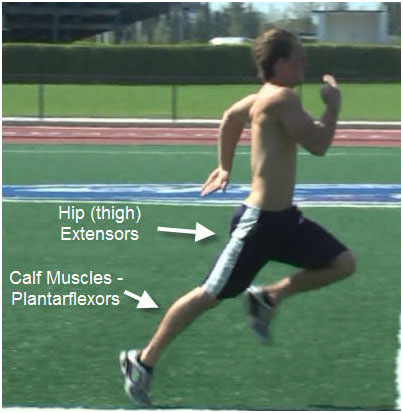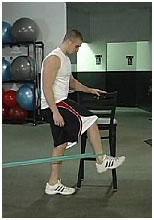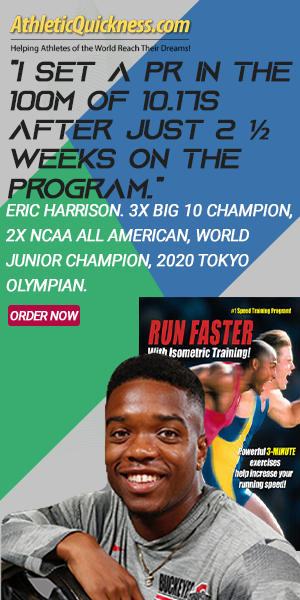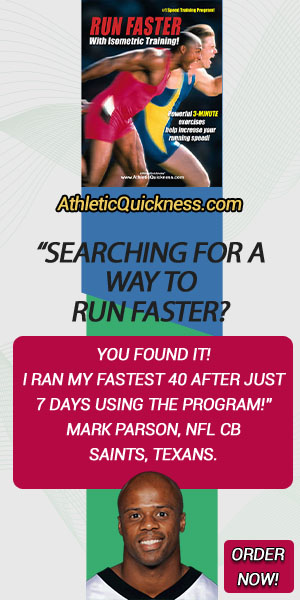You keep doing the same workouts and you’re still missing 50% of the training!
Every athlete who walks into a gym, practice field or track who ‘thinks’ they are training for running speed and then leaves the gym, practice field or track believing they have done everything humanly possible to help them get faster, is always leaving untouched upwards of 50% of the muscles responsible to make them faster.
That’s right, half the muscles involved in running go untrained.
If that’s true, do you think this could be the problem resulting in little or no improvements in speed gains?
That is really only part of the problem – it’s actually much bigger than that, but it’s the one thing I will address here.
And this happens to close to 100% of all athletes on all levels from high school to professionals; it doesn’t matter who they are or how hard they try.

Right Leg at End of Push Phase
There are several reasons why half the muscles involved in running go untouched.
First, ALL gym equipment is designed to help an athlete with the PUSH PHASE of running only but there are actually two other phases to consider. Squat racks, hamstring curls, leg extensions, leg presses, glute kick backs, lunges, etc. all target the hip extensors, leg extensors and calf muscles. While these exercises are helpful, the muscles they target are for the PUSH PHASE ONLY.
Second, ALL plyometric exercises do the same thing: box jumps, bounding exercises, steps, medicine ball workouts, etc. all target the same muscles except they add the element of motion to them. Good idea, but it won’t change anything much more than what you are already doing, and that is ‘overtraining’ the muscles involved in the push phase.
Third, creative pieces of equipment like running with a weight sled or parachute tied around your waist still only target the same muscles involved in the push phase that the weight machines do and plyometric exercises are already doing.
Fourth, resistance bands are also used for a number of different exercises but two things happen when you hand someone a band: one of them is that they take the band and start to simulate a common weight training exercise where they start doing repetitions with the bands…a bad idea since bands are weak in the beginning and strong at the end and the value of them drops because of it.
The other thing is that when it comes to sports, the bands are often used the same way as a weight sled or parachute. This is where the athlete ties the band around his waist and you have another athlete or trainer hold the band behind them as they try to run forward. Nice idea, but no change in muscles targeted which are all push phase muscles only.
They All Target The Same Muscles
From pushing weight sleds to flipping truck tires…all good exercises but again, they only target the Push Phase muscles.
Do you see a pattern? All this effort is being put into only one phase of running. This is why you and other athletes are not getting faster!
Now the muscles I am going to tell you about aren’t anything new that people haven’t heard about in the past. I didn’t invent them or discover them.
The problem is, no one really knows why they are important or places as much value on them in running and because they are hidden under your clothes over the midsection of the body, there is no attractive reason to ever consider making them the focus of your sprint training.
Even when people think they are training these muscles that I am going to tell you about, they never engage them properly and are only touching the surface of the potential these muscles have when it comes to running.
The Muscles That Are Ignored
The muscles I am talking about are the Psoas, Iliacus, Sartorius, Vastus Rectus, Pectineus, Adductor Longus and Addutor Brevis, otherwise known as your hip flexors.
These muscles as a group constitute the strongest muscle group in the body but in spite of their incredible inherent strength, they still go largely untrained by most athletes, including professionals.
For instance, when was the last time YOU trained your ILIACUS MUSCLE? How about never!
Why is this important? Several reasons:

Right Leg Near End of Swing Phase
First, the hip flexors make up your stride which just so happens to be the part of the running process that determines how much ground you are going to take up when running, but that’s not all. Having a long stride is not nearly as effective as having a FAST LONG STRIDE. Quick hip flexors help your body speed up your turnover rate, that is, to recycle the leg around in the running process. The faster it recycles the faster you start to run.
Second, as you desire to become a complete athlete, try to think of your hip flexors as a bridge between your upper body and lower body. They start high up in you lumbar spine and cross the hip joint and attach into the femur (thigh bone) and some extend across the knee. In all they are at least two feet long. These super long and incredibly strong muscles enable your upper body to work in synch with your lower body, but still no one touches them.
With Weak Hip Flexors You Will Remain Slow
I like to think of them this way: Imagine that your upper body is a steel door and your lower body is a steel door FRAME. If you have plastic hinges (think hip flexors that hinge the upper body to the lower body), then I’m going to break you down and I’m coming through.
I don’t care how strong your upper body is or your lower body. And I don’t care if you can rep 225 lbs. thirty times and squat 465 lbs with ease. What I am saying is that an athlete you can have all the upper body strength and lower body strength in the world but if they aren’t connected together with an equally strong set of hip flexors, then you will always be weaker and slower than your true potential no matter how many squats, leg presses, box jumps or sled pulls you do.
With weak thigh flexors, your running speed will be significantly slower, more than you would imagine.
The good news is that EVERY ATHLETE, including top level professionals, has a HUGE RESEVOIR OF UNTAPPED MUSCULAR ENERGY just waiting to be released. But you can’t get at these muscles with standard gym equipment and other reasons that I won’t mention here.

Conditioning Hip Flexors For Speed of Contraction
The only way I have found to effectively isolate and increase the speed of these muscles is with isometric training using the resistance band. No other workout is more effective at making these muscles faster.
Results are Dramatic and Come in Days
The amount of time needed to train these muscles properly to show measurable improvements in your running speed is literally just minutes a day for just a few days a week, and the number of days needed to verify your progress with a stop watch is around two weeks.
This Happens All the Time and Without Exception.
With fast thigh flexor muscles you will be faster than ever before. Even if you are currently in mid-season you can be outperforming your best in days.
If you do the exercises the way the program tells you, you will be strengthening and quickening all the important muscles you have been missing, plus adding additional speed to all the other muscles you have already been training!
You will get faster just like you would expect to get stronger when you lift weights. No tricks, no gimmicks, just smart training.





